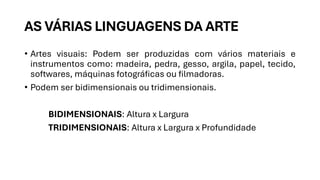AS VÁRIAS LINGUAGENS DA ARTE - CADERNO6A.pdf
•
0 gostou•1 visão
AS VÁRIAS LINGUAGENS DA ARTE - CADERNO6A.pdf
Denunciar
Compartilhar
Denunciar
Compartilhar
Baixar para ler offline

Recomendados
Recomendados
More than Just Lines on a Map: Best Practices for U.S Bike Routes
This session highlights best practices and lessons learned for U.S. Bike Route System designation, as well as how and why these routes should be integrated into bicycle planning at the local and regional level.
Presenters:
Presenter: Kevin Luecke Toole Design Group
Co-Presenter: Virginia Sullivan Adventure Cycling AssociationMore than Just Lines on a Map: Best Practices for U.S Bike Routes

More than Just Lines on a Map: Best Practices for U.S Bike RoutesProject for Public Spaces & National Center for Biking and Walking
Mais conteúdo relacionado
Destaque
More than Just Lines on a Map: Best Practices for U.S Bike Routes
This session highlights best practices and lessons learned for U.S. Bike Route System designation, as well as how and why these routes should be integrated into bicycle planning at the local and regional level.
Presenters:
Presenter: Kevin Luecke Toole Design Group
Co-Presenter: Virginia Sullivan Adventure Cycling AssociationMore than Just Lines on a Map: Best Practices for U.S Bike Routes

More than Just Lines on a Map: Best Practices for U.S Bike RoutesProject for Public Spaces & National Center for Biking and Walking
Destaque (20)
Content Methodology: A Best Practices Report (Webinar)

Content Methodology: A Best Practices Report (Webinar)
How to Prepare For a Successful Job Search for 2024

How to Prepare For a Successful Job Search for 2024
Social Media Marketing Trends 2024 // The Global Indie Insights

Social Media Marketing Trends 2024 // The Global Indie Insights
Trends In Paid Search: Navigating The Digital Landscape In 2024

Trends In Paid Search: Navigating The Digital Landscape In 2024
5 Public speaking tips from TED - Visualized summary

5 Public speaking tips from TED - Visualized summary
Google's Just Not That Into You: Understanding Core Updates & Search Intent

Google's Just Not That Into You: Understanding Core Updates & Search Intent
The six step guide to practical project management

The six step guide to practical project management
Beginners Guide to TikTok for Search - Rachel Pearson - We are Tilt __ Bright...

Beginners Guide to TikTok for Search - Rachel Pearson - We are Tilt __ Bright...
Unlocking the Power of ChatGPT and AI in Testing - A Real-World Look, present...

Unlocking the Power of ChatGPT and AI in Testing - A Real-World Look, present...
More than Just Lines on a Map: Best Practices for U.S Bike Routes

More than Just Lines on a Map: Best Practices for U.S Bike Routes
Ride the Storm: Navigating Through Unstable Periods / Katerina Rudko (Belka G...

Ride the Storm: Navigating Through Unstable Periods / Katerina Rudko (Belka G...
Good Stuff Happens in 1:1 Meetings: Why you need them and how to do them well

Good Stuff Happens in 1:1 Meetings: Why you need them and how to do them well
AS VÁRIAS LINGUAGENS DA ARTE - CADERNO6A.pdf
- 1. AS VÁRIAS LINGUAGENS DA ARTE • Artes visuais: Podem ser produzidas com vários materiais e instrumentos como: madeira, pedra, gesso, argila, papel, tecido, softwares, máquinas fotográficas ou filmadoras. • Podem ser bidimensionais ou tridimensionais. BIDIMENSIONAIS: Altura x Largura TRIDIMENSIONAIS: Altura x Largura x Profundidade
- 2. ELEMENTOS CONSTITUTIVOS DAS ARTES VISUAIS • PONTO - Elemento menor e mais simples das artes visuais. Um único ponto não conseguir construir uma imagem mas, um conjunto de pontos pode-se compor imagens visuais. • LINHA - Conjunto de pontos que se sucedem uns aos outros, em uma sequência infinita. A linha é o elemento visual que mostra direcionamentos e delimita as formas. As linhas podem ser:
- 4. • FORMA – Aspecto exterior dos objetos, que podem ser reais, imaginários ou representados. Uma linha, quando se fecha, dá origem a uma forma. Há 3 formas básicas: o quadrado, o círculo e o triângulo equilátero. Cada forma possui características específicas e a elas é atribuída uma grande quantidade de significados. • TEXTURA: É o elemento visual que expressa a qualidade tátil das superfícies dos objetos. As texturas podem ser divididas em visuais (óticas) e táteis.
- 5. • COR – É o elemento visual que se dá a partir da sensação provocada pela luz sobre os nossos olhos. O pigmento é o elemento que dá cor a tudo que é material; Temos duas formas de dividir as cores: cor-luz e cor-pigmento. Cor-luz pode ser observada a partir dos raios luminosos, é a própria luz que se decompõe em muitas cores. Já a cor-pigmento é a luz que é refletida por um material fazendo com que o nosso olho perceba esse estímulo como cor.